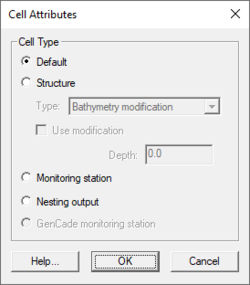SMS:CMS-Wave Cell Attributes Dialog: Difference between revisions
No edit summary |
|||
| Line 44: | Line 44: | ||
Spectral output is generated for nesting output cells cells to be used as input for a [[SMS:Nest_Grid_(STWAVE)|nested child grid]]. | Spectral output is generated for nesting output cells cells to be used as input for a [[SMS:Nest_Grid_(STWAVE)|nested child grid]]. | ||
=== | === GenCade monitoring station === | ||
== Displaying Cell Attributes == | == Displaying Cell Attributes == | ||
Revision as of 19:44, 19 April 2013
The CMS-Wave Cell Attributes dialog is used to assign a cell type to selected Cells. It is opened using the menu command CMS-Wave | Assign Cell Attributes. The following cell types can be assigned:
Default
The elevation values of these cells will be used in order to determine whether flow exists in each cell or not.
Structure
The cell attributes dialog of CMS-Wave supports various structure types. Each type of structure can specify an attribute value. The following structure types are supported:
- Bathymetry modification – for adding alternative feature or structure (immersed or exposed) without modifying the input depth
- Wave runup – for calculation of wave runup and overwash on beach face or structure, and adjacent land
- Floating breakwater – for calculation of transmitted waves of a floating breakwater
- Wall breakwater – for a vertical wall breakwater
- Rubble-mound – for a composite or rubble-mound breakwater
- Piers/docks – High permeability; for a pier or dock
- Rubble-mound breakwater – Low permeability; for a rubble-mound breakwater
Each of the structures can provide an optional attribute value. The value specified is as follows:
| Structure Type | Attribute Name | Description | If Not Provided |
|---|---|---|---|
| Bathymetry modification | Depth | Feature structure depth | Assumed land if not provided |
| Wave runup | Elevation | Beach/structure elevation above mean water level (no effect if < 0.0) | Assumed input depth |
| Floating breakwater | Draft | Floating breakwater draft (no effect if < 0.05 m) | No effect |
| Wall breakwater | Elevation | Beach/structure elevation above mean water level (immersed if < 0.0) | Assumed input depth |
| Rubble-mound | Elevation | Beach/structure elevation above mean water level (immersed if < 0.0) | Assumed input depth |
| Piers/docks – High permeability | Porous layer thickness | See permeable structures below. | |
| Rubble-mound breakwater – Low permeability | Porous layer thickness | See permeable structures below. |
Permeable Structures
CMS-Wave treats cells designated as "Piers/Docks" and "Rubble Mound Breakwater" as if they have a structure that fills the entire water column. If the water level rises, the assumption is made that the structure is still all the way to the water surface (and beyond if needed). CMS-Wave ignores the specified depth for these cells when the structure type is specified. The layer thickness defines the thickness that will convey wave energy. Physically, this is like the distance from the mean sea level down to the footing of the pier group or dock structure. For a rubble mound, it is the distance below mean sea level where the mound sits on solid material (non-permeable).
Monitoring Station
Spectral output is generated for cells designated as monitoring station cells.
Nesting output
Spectral output is generated for nesting output cells cells to be used as input for a nested child grid.
GenCade monitoring station
Displaying Cell Attributes
The symbols and colors used to identify the attributes assigned to cells can be changed in the STWAVE Display Options.
Related Topics
SMS Menu Bars | |
|---|---|
| Standard Menus: | File • Edit • Display • Window • Help |
| Module Menus: | 2D Mesh • Cartesian Grid • Curvilinear Grid • GIS • Map • Particle • Quadtree • Raster • Scatter |
| Model Menus: | ADCIRC • BOUSS-2D • CGWAVE • CMS-Flow • CMS-Wave • FESWMS • Generic Model • GenCade • PTM • RMA2 • RMA4 • SRH-2D • STWAVE • TUFLOW |
SMS – Surface-water Modeling System | ||
|---|---|---|
| Modules: | 1D Grid • Cartesian Grid • Curvilinear Grid • GIS • Map • Mesh • Particle • Quadtree • Raster • Scatter • UGrid |  |
| General Models: | 3D Structure • FVCOM • Generic • PTM | |
| Coastal Models: | ADCIRC • BOUSS-2D • CGWAVE • CMS-Flow • CMS-Wave • GenCade • STWAVE • WAM | |
| Riverine/Estuarine Models: | AdH • HEC-RAS • HYDRO AS-2D • RMA2 • RMA4 • SRH-2D • TUFLOW • TUFLOW FV | |
| Aquaveo • SMS Tutorials • SMS Workflows | ||
